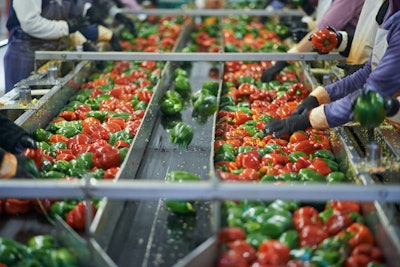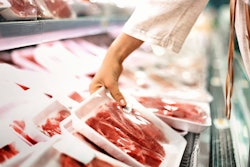
Between years of variable crop yields and volatile markets, the logistics around food is impacted by a range of concerns. Supply challenges like seasonality, perishability, evolving consumer tastes and safety and quality issues can all negatively impact food and beverage supply chain efficiency.
Since supply chain efficiency is vital to profitability and safety, food and beverage industry companies are turning to new technologies to enable transparent and sustainable supply chains and meet our planet’s ever-evolving demands for sustainable food from production and processing to transportation and storage. Understanding the science of food through measurement and data intelligence across its lifecycle is essential to the ongoing success of the food and beverage industries.
Production innovations
It all starts with the production processes. During the ingredient production phase, food producers can optimize carbon dioxide (CO2) in greenhouses to increase crop productivity and quality. CO2 is used by plants to grow by photosynthesis, so it is common to raise greenhouse CO2 levels to boost production. In fact, optimizing carbon dioxide concentrations can raise productivity by as much as 40%, while using too much CO2 increases costs and can be harmful to crops. The optimal carbon dioxide concentration (between 800-1,000 ppm) also improves the quality of the produce.
With the optimal carbon dioxide conditions depending on the plant and light conditions in the greenhouse, optimizing CO2 levels requires continuous and accurate information from indoor and outdoor environments. Inside greenhouses, CO2, relative humidity and temperature are typically measured, while wind speed and direction, precipitation and solar radiation are the outside parameters affecting CO2 optimization. Depending on the crop grown and the desired level of photosynthetic activity, optimal greenhouse temperatures - between 60–75° F or 16-24° C - and the most favorable level of relative humidity - typically between 50-70% - can significantly vary.
Knowledge of these growth factors and how they interact is essential to the crop’s well-being, productivity and quality. As a result, farmers and other food producers must effectively monitor CO2, relative humidity and temperature conditions to unlock a new level of primary agricultural production.
Processing innovations
Accurate and reliable measurements and data also play an important role in food processing to avoid poor energy efficiency and low product quality during processing. Finding and maintaining optimal operating conditions is critical to lowering operating costs and increasing energy efficiency. As such, measuring important parameters enables decision-makers to optimize food and beverage processing and control operations. The critical measurements in food and beverage production include relative humidity, CO2 and in-line Brix or dry solids.
Relative humidity is measured to streamline food drying processes, which are important in improving global food production and safety. Proper drying and moisture removal can not only reduce packaging, storage and transportation costs, but it also prevents microbial growth and reproduction and reduces moisture-induced biochemical reactions, thereby extending the shelf life of products and perhaps even enhancing product quality.
Important for keeping employees safe and goods fresh, CO2 measurements can also help the food processing segment boost production, while ensuring employee safety. From greenhouses and fruit/vegetable storage facilities to supermarkets and cold storage monitoring, optimal CO2 levels can increase production and quality. However, because excessive levels of CO2 can displace oxygen, causing tiredness, unconsciousness or even death, accurate CO2 monitoring is essential to avoid accumulation and ensure employee safety.
In-line Brix and dry solids monitoring helps manufacturers successfully perform food and beverage production tasks by allowing for real-time, continuous, automated process control without compromising measurement accuracy. The traditional method of manually collecting measurements and analyzing samples in a laboratory is expensive and time-consuming. Plus, manual data collection and analysis prolongs the ability to optimize process and product quality control procedures. Employing the traditional approach, any products that fall outside of acceptable values are likely to have traveled through the product quality control process before an alarm can be raised, and this may result in significant product wastage.
Effectively measuring and understanding how these critical processing parameters impact operations allows food and beverage processors to enable a traceable and transparent value chain that ensures the efficiency and safety of production tasks, eliminates food waste and reduces energy usage, thereby sustainably providing the world’s growing population with sufficient safe, easy-to-access food.
Transportation and storage innovations
Transportation and storage conditions shape the freshness, taste and safety for consumption and shelf life of various foods and beverages.
From storage facilities, ripening rooms, freezers and refrigerators to transportation vehicles, retail outlets, storage and transportation, CO2 needs to be monitored across a variety of environments to ensure process safety, productivity and product quality. Better control leads to higher, more consistent product quality, so reliable CO2 measurement can help increase safety, prevent overcooling, which consumes a significant amount of energy and money) ensure optimal refrigerator performance and quickly locate leaks to save both energy and refrigerant. Optimal transportation and storage conditions also depend on humidity and temperature measurements to improve energy efficiency and prevent frost buildup and condensation by reducing unnecessary heating and defrosting.
Ensuring proper preservation of food items, timely ripening of fruits, vegetables and seasonal food varieties for consumers in different destinations and working safely for storage and production personnel relies on accurate monitoring and control of temperature, humidity and carbon dioxide.
Retail innovations
While many believe that supply chain innovation ends once products find their way onto grocery store shelves, there are several food retail innovations coming online to protect health and safety and ensure product quality.
Again, high CO2 concentrations are dangerous, but as more countries utilize environmentally friendly refrigerators in supermarkets, CO2 — the ideal natural refrigerant — is replacing synthetic refrigerants in all retail refrigeration. As a result, accurate, reliable CO2 monitoring is necessary to ensure safety and the rapid detection of potential leaks.
Additionally, monitoring relative humidity in retail food stores can aid in protecting fruit and vegetables against moisture loss, decay, and aging, and ensure optimal product quality. Retail decision-makers who leverage accurate relative humidity measurements to understand the effects of changes in ambient conditions can make adjustments accordingly.
Supply chain innovation: More science than art
In the world of food logistics, science rules. Measurement data from innovative instruments informs decisions, enables efficiency optimization, improves sustainability, enhances and protects product consistency and quality and lowers operating costs. As we continue to revolutionize food and beverage industry supply chains — from production and processing to storage, distribution and retail — science-driven innovation is necessary at each stage of the food and beverage value chain to create a sustainable future.


















